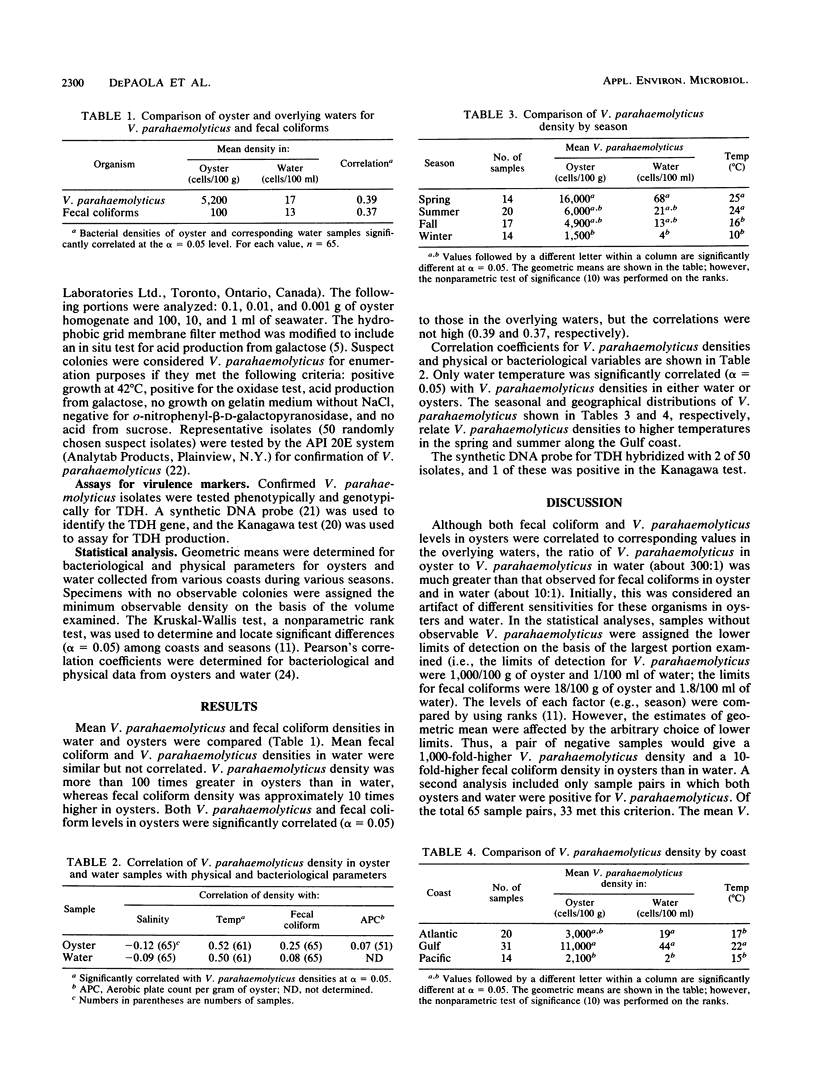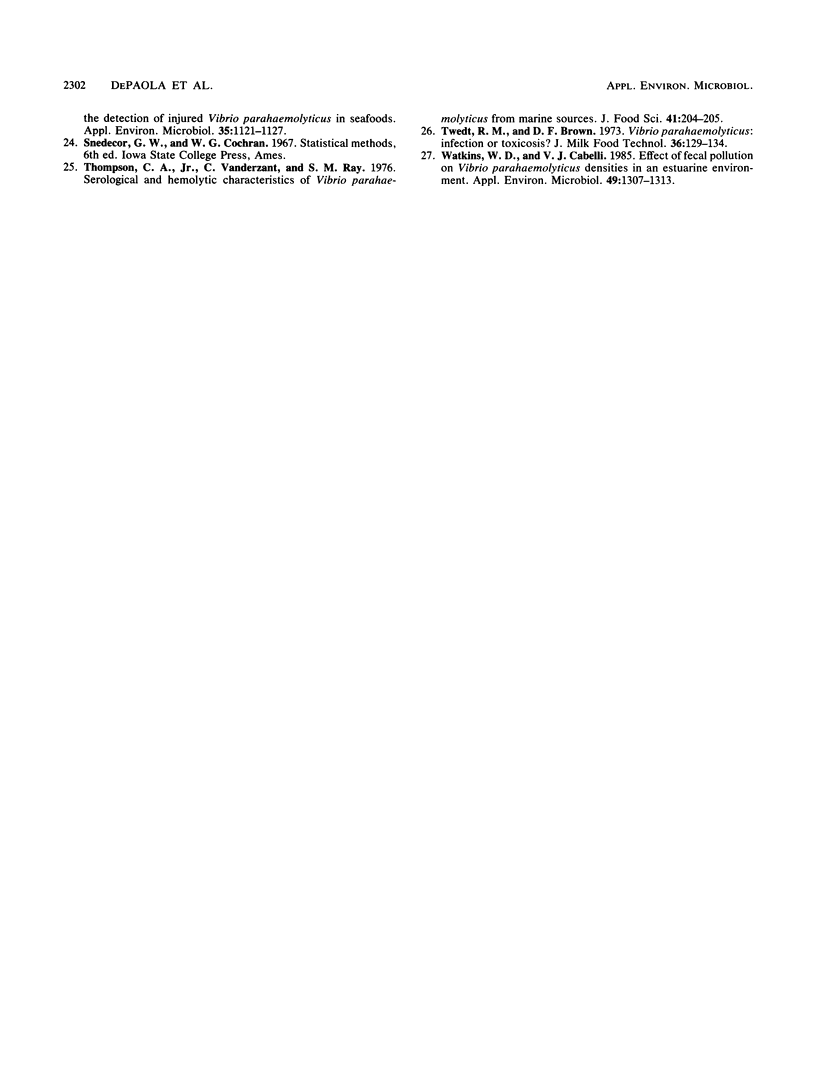Abstract
Oyster and seawater samples were collected seasonally from May 1984 through April 1985 from shellfish-growing areas in Washington, California, Texas, Louisiana, Alabama, Florida, South Carolina, Virginia, and Rhode Island which had been designated as approved or prohibited by the National Shellfish Sanitation Program. Fecal coliforms counts, aerobic plate counts, and Vibrio parahaemolyticus densities were determined for the samples. Mean V. parahaemolyticus density was more than 100 times greater in oysters than in water, whereas density of fecal coliforms was approximately 10 times higher in oysters. Seasonal and geographical distributions of V. parahaemolyticus were related to water temperature, with highest densities in samples collected in the spring and the summer along the Gulf coast. The synthetic DNA probe for thermostable direct hemolysin hybridized with 2 of 50 isolates, 1 of which was positive by the Kanagawa test.
Full text
PDF



Selected References
These references are in PubMed. This may not be the complete list of references from this article.
- Bartley C. H., Slanetz L. W. Occurrence of Vibrio parahaemolyticus in estuarine waters and oysters of New Hampshire. Appl Microbiol. 1971 May;21(5):965–966. doi: 10.1128/am.21.5.965-966.1971. [DOI] [PMC free article] [PubMed] [Google Scholar]
- DePaola A., Hopkins L. H., McPhearson R. M. Evaluation of four methods for enumeration of Vibrio parahaemolyticus. Appl Environ Microbiol. 1988 Feb;54(2):617–618. doi: 10.1128/aem.54.2.617-618.1988. [DOI] [PMC free article] [PubMed] [Google Scholar]
- Earle P. M., Crisley F. D. Isolation and characterization of Vibrio parahaemolyticus from Cape Cod soft-shell clams (Mya arenaria). Appl Microbiol. 1975 May;29(5):635–640. doi: 10.1128/am.29.5.635-640.1975. [DOI] [PMC free article] [PubMed] [Google Scholar]
- El-Sahn M. A., El-Banna A. A., El-Tabey Shehata A. M. Occurrence of Vibrio parahaemolyticus in selected marine invertebrates, sediment, and seawater around Alexandria, Egypt. Can J Microbiol. 1982 Nov;28(11):1261–1264. doi: 10.1139/m82-187. [DOI] [PubMed] [Google Scholar]
- Honda T., Ni Y. X., Miwatani T. Purification and characterization of a hemolysin produced by a clinical isolate of Kanagawa phenomenon-negative Vibrio parahaemolyticus and related to the thermostable direct hemolysin. Infect Immun. 1988 Apr;56(4):961–965. doi: 10.1128/iai.56.4.961-965.1988. [DOI] [PMC free article] [PubMed] [Google Scholar]
- Honda T., Ni Y., Miwatani T. Purification of a TDH-related hemolysin produced by a Kanagawa phenomenon-negative clinical isolate of Vibrio parahaemolyticus 06: K46. FEMS Microbiol Lett. 1989 Jan 15;48(2):241–245. doi: 10.1111/j.1574-6968.1989.tb03307.x. [DOI] [PubMed] [Google Scholar]
- Kaneko T., Colwell R. R. Ecology of Vibrio parahaemolyticus in Chesapeake Bay. J Bacteriol. 1973 Jan;113(1):24–32. doi: 10.1128/jb.113.1.24-32.1973. [DOI] [PMC free article] [PubMed] [Google Scholar]
- Kaneko T., Colwell R. R. Incidence of Vibrio parahaemolyticus in Chesapeake Bay. Appl Microbiol. 1975 Aug;30(2):251–257. doi: 10.1128/am.30.2.251-257.1975. [DOI] [PMC free article] [PubMed] [Google Scholar]
- Kaper J., Lockman H., Colwell R. R., Joseph S. W. Ecology, serology, and enterotoxin production of Vibrio cholerae in Chesapeake Bay. Appl Environ Microbiol. 1979 Jan;37(1):91–103. doi: 10.1128/aem.37.1.91-103.1979. [DOI] [PMC free article] [PubMed] [Google Scholar]
- Kelly M. T. Effect of temperature and salinity on Vibrio (Beneckea) vulnificus occurrence in a Gulf Coast environment. Appl Environ Microbiol. 1982 Oct;44(4):820–824. doi: 10.1128/aem.44.4.820-824.1982. [DOI] [PMC free article] [PubMed] [Google Scholar]
- Kelly M. T., Stroh E. M. Temporal relationship of Vibrio parahaemolyticus in patients and the environment. J Clin Microbiol. 1988 Sep;26(9):1754–1756. doi: 10.1128/jcm.26.9.1754-1756.1988. [DOI] [PMC free article] [PubMed] [Google Scholar]
- Miyamoto Y., Kato T., Obara Y., Akiyama S., Takizawa K., Yamai S. In vitro hemolytic characteristic of Vibrio parahaemolyticus: its close correlation with human pathogenicity. J Bacteriol. 1969 Nov;100(2):1147–1149. doi: 10.1128/jb.100.2.1147-1149.1969. [DOI] [PMC free article] [PubMed] [Google Scholar]
- Nishibuchi M., Hill W. E., Zon G., Payne W. L., Kaper J. B. Synthetic oligodeoxyribonucleotide probes to detect Kanagawa phenomenon-positive Vibrio parahaemolyticus. J Clin Microbiol. 1986 Jun;23(6):1091–1095. doi: 10.1128/jcm.23.6.1091-1095.1986. [DOI] [PMC free article] [PubMed] [Google Scholar]
- Overman T. L., Kessler J. F., Seabolt J. P. Comparison of API 20E, API rapid E, and API rapid NFT for identification of members of the family Vibrionaceae. J Clin Microbiol. 1985 Nov;22(5):778–781. doi: 10.1128/jcm.22.5.778-781.1985. [DOI] [PMC free article] [PubMed] [Google Scholar]
- Watkins W. D., Cabelli V. J. Effect of fecal pollution on Vibrio parahaemolyticus densities in an estuarine environment. Appl Environ Microbiol. 1985 May;49(5):1307–1313. doi: 10.1128/aem.49.5.1307-1313.1985. [DOI] [PMC free article] [PubMed] [Google Scholar]


